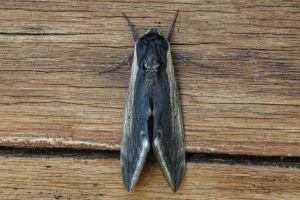

 +3Kontinente:EUNA
+3Kontinente:EUNA1. Lebendfotos
1.1. Falter
2. Biologie
2.1. Nahrung der Raupe
- [Rosaceae:] Prunus domestica (Pflaume)
- [Rosaceae:] Prunus avium (Süß-Kirsche)
- [Rosaceae:] Prunus persica (Pfirsich)
- [Rosaceae:] Prunus maritima (Strand-Pflaume)
- [Rosaceae:] Prunus serotina (Späte Traubenkirsche)
- [Rosaceae:] Prunus sp.
- [Rosaceae:] Malus sp. (Apfel)
- [Cannabaceae:] Celtis occidentalis (Amerikanischer Zürgelbaum)
- [Oleaceae:] Syringa vulgaris ?? (Flieder ??)
Die Autoren der [mothphotographersgroup.msstate.edu] schreiben zur Raupennahrung: "Foodplants include apple, cherry, peach, plum, lilac and hackberry." Es dürfte sich dabei durchweg um Freiland-Raupennahrungspflanzen handeln. Die Angabe zu "hackberry" (Celtis occidentalis) geht dabei auf die Erstbeschreibung von Smith (1797: 71) zurück, der schrieb: "Taken feeding on the Sugar-berry or Hack-berry, but it is most frequent on the Plum."
3. Weitere Informationen
3.1. Faunistik
Die Art wurde aus den USA (Georgia) beschrieben und Smith (1797: 71) macht gleich darauf aufmerksam, dass die Falter auf den ersten Blick kaum von Sphinx ligustri zu unterscheiden sind - er nennt aber einige hilfreiche Merkmale.
Auf der Artseite der [mothphotographersgroup.msstate.edu] heißt es zur Verbreitung in Nordamerika: "An uncommon species, ranges coast-to-coast from Nova Scotia to British Columbia southward where, excepting Florida and the desert southwest, it is found in the northern portions of the Gulf States and northern California."
Die einzige Meldung der Art aus Europa findet sich bei Agassiz et al. (2013: 120); sie betrifft eine Verschleppung nach England: "Weston-super-Mare, Somerset, 1965. Nearctic."
(Autor: Erwin Rennwald)
3.2. Literatur
- Agassiz, D.J.L., Beavan, S.D. & R.J. Heckford (2013): Checklist of the Lepidoptera of the British Isles. Royal Entomological Society. 206pp.
- Erstbeschreibung: Smith, J.E. (1797): The Natural History of the rarer Lepidopterous Insects of Georgia. Including their systematic characters, the particulairs of their several metamorphoses and the plants on which tey feed. Collected from the observations of Mr. John Abbot, many years resident in that country. 2: 101-214. London (T. Bensley). S. 105–106. [Tab. LIII. Phalæna opercularis auf biodiversitylibrary.org], [p. 105 auf biodiversitylibrary.org] bzw. [Digitalisat auf archive.org]





